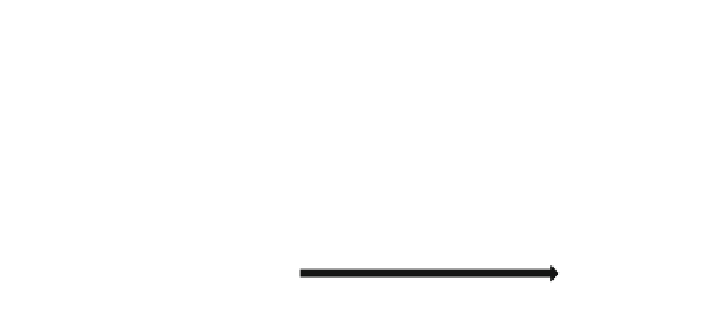Biomedical Engineering Reference
In-Depth Information
Fig. 5 Schematic
representation of the response
time sequence after
implantation of a medical
device. Adapted from
Anderson [
3
]
implant
Implantation
acute chronic granulation tissue
Protein adsorption
Neutrophils
Macrophages
Neovascularization
Foreign body giant cells
Fibroblasts
Fibrosis
Leucocytes
Dense collagen capsule
min. h. days weeks months
Time
and (iii) topography and porosity influences. The chemical properties include
aspects of chemical functionalities of the cells/tissue, biomacromolecule coating,
chemical patterning of surfaces, or absorption and degradation behaviour including
secondary metabolic compounds (e.g. [
74
]). The mechanical properties of a bio-
material, i.e. its elastic modulus, pressure, and flow, influence to a large extent cell
behaviour and tissue formation adjacent to the biomaterial [
54
]. Most cells are
mechano-sensitive and have at their surfaces elements that respond to mechanical
stimulations. Good examples of that responsiveness are muscle cells, chondro-
cytes, bone cells, nerve cells and dendritic cells. Last but not least, cells are
influenced by the surrounding topography. One of the best investigated examples
is the so-called SLA surface-grid blast and acid-etched surfaces of dental implants.
That treatment introduces macro-, micro- and nanometer 3D surface structures on
titanium metal surfaces favouring the functionality of osteoblast cells and allowing
enhanced and fast osseointegration of the implants [
42
,
129
]. Separating the
reaction towards each characteristic is, however, only of theoretical interest. Cells
always respond to all of these characteristics of a biomaterial [
84
,
125
].
The extent of these influences varies from general to cell-type specific. Cell-
type-specific effects may results in a shift in the original tissue composition of the
cells in the environment of the implant and thus result in a (pathological) change in
its functional characteristics. For instance, in the bone environment, bone tissue
may alter locally in soft tissue after placing a new implant. Surface nanostructures
and chemistry, including surface charges and the bioenvironment, i.e. local tissues
and fluids, will in their combined action influence which set of proteins will adsorb
to the surface, in which orientation they will adhere and in how far after adhesion
these proteins will change their conformation, with denaturation as the most
extreme situation [
92
,
113
,
135
,
150
,
156
]. Protein adsorption occurs immediately
upon contact with the biomaterial and fibronectin and albumin adsorb predomi-
nantly, due to their serum concentrations. Depending on the material, equilibrium
in protein adhesion regarding protein quantity, composition and z-potential is
reported to be reached after 1-24 h after immersion in protein solutions, during































Search WWH ::

Custom Search